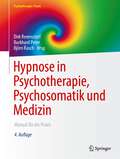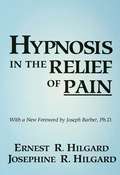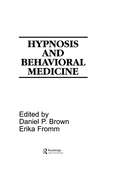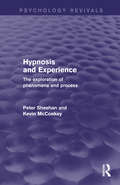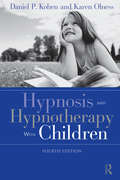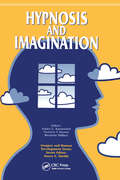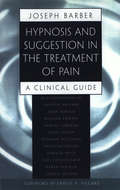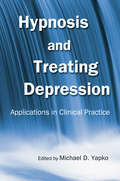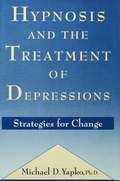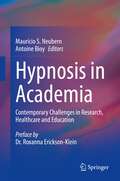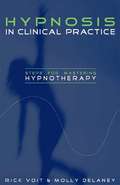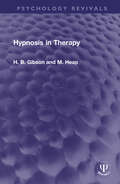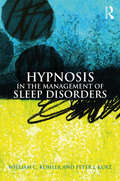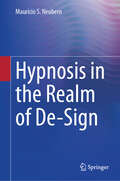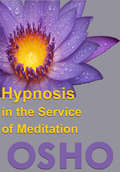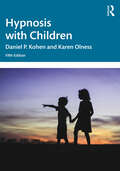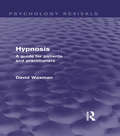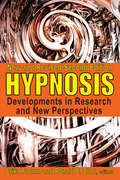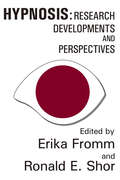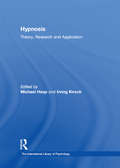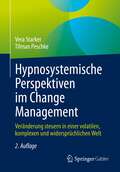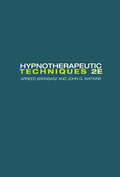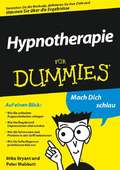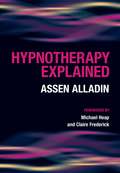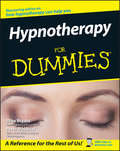- Table View
- List View
Hypnose in Psychotherapie, Psychosomatik und Medizin: Manual für die Praxis (Psychotherapie: Praxis)
by Dirk Revenstorf Burkhard Peter Björn RaschDas Buch hat sich inzwischen zu einem Standardwerk der modernen Hypnotherapie in allen Anwendungsfeldern entwickelt. Ärzte und Psychotherapeuten erhalten praktische Anleitungen für die hypnotherapeutische Behandlung einzelner Störungen und werden mit den theoretischen Grundlagen vertraut gemacht. Zugleich ist es ein Ausbildungsmanual für klinische und medizinische Hypnose und ist daher für Ausbildungskandidaten und für Praktiker geeignet. Für die Neuauflage wurden alle Kapitel grundlegend aktualisiert und überarbeitet. Aus dem Inhalt: Allgemeine Prinzipien – Induktionen – Allgemeine Methoden – Verhaltensstörungen, Neurosen, Psychosen, Persönlichkeitsstörungen – Schmerz – Psychosomatik – Hypnose bei Kindern und Jugendlichen. Die Herausgeber: Professor Dr. Dirk Revenstorf, Universität Tübingen. Dipl.-Psych. Dr. Burkhard Peter, MEG-Stiftung München. Professor Dr. rer. nat. Björn Rasch, Universität Freiburg/Schweiz.
Hypnosis In The Relief Of Pain
by Ernest R. Hilgard Josephine R. HilgardWritten by a psychologist and a psychiatrist noted for their expertise as both practitioners and researchers, the book illustrates how hypnosis can significantly alleviate the pain of childbirth, medical or dental surgery, burns or other accidental injuries, cancer, and chronic syndromes. With over 600 references covering the field of modern research into the mechanisms of pain, the authors convey a thorough understanding of findings and limitations of available empirical studies. Yet the book remains exceptionally clear and non-technical and will appeal not only to professionals involved with pain reduction but to lay people as well. The Hilgards address a broad spectrum of topics relating to hypnosis and pain, ranging from an historical review to a consideration of future areas for investigation. They thoughtfully tackle the controversy still surrounding the nature of hypnosis - is it an altered state of consciousness or a pattern of behaviour adopted by both subject and hypnotist? The concluding section presents the Hilgards' neo-dissociation theory of hypnosis as well as a highly useful technique for assessing susceptibility in clinical situations. Pain has been called the greatest unsolved problem in medicine. Hypnosis in the Relief of Pain, with its honest and complete appraisal of the role of hypnosis on pain reduction, will contribute significantly to the understanding and broader use of this noninvasive and natural healing phenomenon.
Hypnosis and Behavioral Medicine
by Daniel P. Brown Erika FrommThis important volume applies hypnotic principles to the specific challenges of behavioral medicine. Drawing from extensive clinical evidence and experience, the authors describe how hypnobehavioral techniques can help in the treatment of psychophysiological disorders.
Hypnosis and Experience: The Exploration of Phenomena and Process (Psychology Revivals)
by Peter W. Sheehan Kevin M. McConkeyThe subject of hypnosis has not lost any of its ability to fascinate and intrigue – and this holds equally true for both the layperson and the student of hypnotic behavior. Phenomena of hypnosis range from simple tasks involving ideomotor response to more complex tasks involving substantial distortions of perceived reality such as age regression, hallucination, and amnesia. Obviously, with a topic so diverse and so interesting, there are plenty of books around. Originally published in 1982, what makes this title stand out is the authors’ focus: instead of trying to survey the whole field and evaluate the full spectrum of theories about hypnosis, they hone in on specific points of view with the aim of illustrating the nature of hypnotic phenomena.
Hypnosis and Hypnotherapy With Children: Third Edition
by Daniel P. Kohen Karen OlnessUpdated and revised in response to developments in the field, this Fourth Edition of Hypnosis and Hypnotherapy With Children describes the research and clinical historical underpinnings of hypnosis and hypnotherapy with children and adolescents, and presents an up-to-date compendium of the pertinent world literature regarding this topic. The authors focus on the wide variety and scope of applications for hypnotherapy; including an integrated description of both clinical and evidence-based research as it relates to understanding approaches to various clinical situations, case studies of practical aspects, and how-to elements of teaching hypnotherapeutic skills to clients.
Hypnosis and Imagination (Imagery and Human Development Series)
by Benjamin Wallace Robert G. Kunzendorf Nicholas P. SpanosThe book's first three chapters-by Sheehan and Robertson; Wagstaff; Council, Kirsch, and Grant - conclude that three different factors turn imagination into hypnosis. The next three chapters-by Lynn, Neufeld, Green, Rhue, and Sandberg; Rader, Kunzendorf, and Carrabino; and Barrett-explore the hypnotic and the clinical significance of absorption in imagination. Three subsequent chapters-by Coe; Gwynn and Spanos; and Gorassini-examine the role of compliance and imagination in various hypnotic phenomena. Pursuing the possibility that some hypnotic hallucinations are experienced differently from normal images, the following two chapters-by Perlini, Spanos, and Jones; and Kunzendorf and Boisvert-focus on negative hallucinating, which reportedly "blocks out" perceptual reality. The remaining three chapters-by Wallace and Turosky; Crawford; and Persinger-pursue other physiological differences, and possible physiological connections, between hypnosis and imagination.
Hypnosis and Suggestion in the Treatment of Pain: A Clinical Guide
by Joseph Barber Ernest R. HilgardWhen a patient's suffering is not adequately managed by the best medical interventions available, the clinician may feel at a loss. This book offers guidance from the field's most respected experts on the psychological assessment and treatment of pain, particularly with hypnosis. It covers both syndromes of special interest (cancer pain, recurrent pain syndromes, headache, burn patients, etc.) and special populations (children and the elderly).
Hypnosis and Treating Depression: Applications in Clinical Practice
by Michael D. YapkoMichael Yapko’s seminal 1992 book, Hypnosis and the Treatment of Depressions, was the first book ever written on the subject of applying hypnosis in the treatment of depressed individuals. Since its publication, Yapko’s work has not only withstood the test of colleagues previously dismissive of the merits of hypnosis as a tool of treatment, but has thrived in the face of it. Hypnosis and Treating Depression diversifies the range of topics to consider and increases the number of knowledgeable contributors on the subject of treating depression with hypnosis. The book features chapter contributions by highly experienced and well-known experts on using hypnosis to treat specific forms of depression, with assessment and intervention strategies as well as sample transcripts of the use of hypnosis in therapy sessions. It discusses both broad and targeted applications of hypnosis in treatment, the treatment of depression with hypnosis in special populations, as well as special considerations regarding hypnotic treatment. As a practical guidebook for clinicians looking to add to their treatment protocols, Hypnosis and Treating Depression: Applications in Clinical Practice provides an updated and comprehensive volume on therapeutic uses of hypnosis in the treatment of depression.
Hypnosis and the Treatment of Depressions: Strategies for Change
by Michael D. YapkoIn this book, Yapko not only demonstrates hypnosis is a viable and powerful approach to the treatment of depression but also confronts traditional criticism of its use head on. He first lays the groundwork for the book's dual focus, opening with a discussion of depressions. He then focuses on the historical perspective of depression and hypnosis as "forbidden friends," shedding new light on old myths about the use of hypnosis leading to hysteria, and even suicide. The result is a definition of hypnosis as a flexible and enlightened tool that offers precisely the multidimensionality that the problem demands.
Hypnosis in Academia: Contemporary Challenges in Research, Healthcare and Education
by Maurício S. Neubern Antoine BioyThis book analyzes the growing presence of hypnosis in academic settings around the world and its implications for research, healthcare and education. The increasing volume of scientific research on hypnosis and its clinical applications to treat health conditions such as pain, anxiety, trauma and depression has renewed the interest for this kind of practice in different disciplines, such as medicine, psychology, dentistry and nursing. As a result of this growing interest, there is an increasing number of spaces occupied by hypnosis in universities of different countries compared to what occurred in recent decades. Nevertheless, what this means, at various levels, is still far from being deciphered, due to the absence of more detailed research and surveys involving a larger number of institutions, students, faculty and research groups. This volume intends to shed a new light into the discussions about the growing presence of hypnosis in academia by bringing together contributions of practitioners and researchers working with hypnosis in academic settings in ten countries from different parts of the world: Belgium, Brazil, Canada, Cuba, France, Hungary, Israel, Portugal, Russia and Switzerland. The discussions presented in these contributions revolve around four axes of analysis: the historical trajectory of hypnosis within academic institutions; the epistemological nature of hypnosis and its relationships with other fields of knowledge; the importance of scientific research for the current development of hypnosis and its clinical applications; and how teaching and training in hypnosis is organized in universities today, with its ethical and legal implications in different cultural contexts. Hypnosis in Academia: Contemporary Challenges in Research, Healthcare and Education will be a great resource for both researchers and practitioners working with hypnosis, and a valuable source of information for human and social scientists in general interested in understanding how a once discredited practice regained respect from the academic community and is now a growing topic of interest for scholars and clinicians all around the world.
Hypnosis in Clinical Practice: Steps for Mastering Hypnotherapy
by Molly Delaney Rick VoitThis book is aimed at helping both newly trained and experienced mental health professionals become comfortable and adept in using hypnosis in their clinical practice. Despite dramatic evidence of the effectiveness of hypnosis and its growing acceptance, only a small percentage of psychotherapists employ their hypnotherapy training in their practices. This under-use of hypnosis is due to exaggerated misconceptions about its power and the resultant performance anxiety therapists experience after their training. This text is designed to address therapist performance anxiety surrounding the use of hypnosis by exploring the myths surrounding its power and therapeutic potential. The integration of a straightforward systematic hypnotic approach into therapeutic practice has value both in assessment and treatment. Using clinical anecdotes and personal experience, the authors of Hypnosis in Clinical Practice explain induction style and trance work in a way that is fundamental and highly accessible.
Hypnosis in Therapy (Psychology Revivals)
by H. B. Gibson M. HeapOriginally published in 1991, this book covers a comprehensive range of the applications of hypnotic techniques in therapy for psychological disorders, and medical conditions where such techniques are a valuable adjunct. In the years before publication psychologists, medical doctors, dentists and allied professional workers had come to make increasing use of hypnosis in their work, and there was a considerable amount of relevant research literature available in journals. Such literature is reviewed, and served as a practical guide for professionals at the time.The book begins by explaining what is meant by hypnosis today, and traces its historical background. Some fundamental questions such as individual differences in susceptibility to hypnosis are discussed in relation to therapy. Separate chapters are devoted to the key topics of behaviour therapy, different forms of psychotherapy, psychosomatic medicine, the treatment of pain, and applications in medical and surgical procedures. The modern status of hypnotic techniques in obstetrics and in dentistry is reviewed, and a separate chapter on the use of hypnosis with children will be of special interest to educational and clinical psychologists. A final chapter reviews the use of hypnosis by various professions and para-medical disciplines, and discusses the possible abuses that may arise both through unqualified people seeking to practise "hypnotherapy", and by professionals acting outside their proper range of competence.
Hypnosis in the Management of Sleep Disorders
by William C. Kohler Peter J. KurzHypnosis in the Management of Sleep Disorders combines history and medical science to show that the use of hypnosis and hypnotic techniques is effective in the treatment of sleep disorders -- and that this is increasingly validated through modern tools (computers, fMRI images). Dr. Kohler and Kurz show readers that hypnosis and hypnotic techniques are not to be feared or avoided, but that their use can contribute to effective, non-intrusive, and cost-effective approaches to the treatment of sleep problems. This volume is a much needed reference for therapists and their patients alike on how hypnosis can be helpful in the treatment of certain sleep disorders.
Hypnosis in the Realm of De-Sign
by Maurício S. NeubernThis book presents a new theoretical framework for the study of hypnosis based on an innovative epistemological approach called De-sign. This approach transcends the opposition subjectivity-objectivity and presents itself as a metaknowledge that integrates design and semiotics and proposes a phenomenological method of inquiry that helps overcome some of the traditional challenges to create theoretical models to explain hypnosis. Both hypnosis and De-sign are critical practices against absolute notions of reality, especially regarding time, space, and otherness. Both of them consider the importance of epistemological notions such as imagination, feelings, and desire, that modern science commonly marginalizes. Hypnosis and De-sign implicate people in partnership, being critical to a dominant notion of control. Thus, the book presents in-depth discussions on major themes of hypnosis, bringing clinical practice closer to the reflections brought by De-sign. Hypnosis in the Realm of De-Sign shows how to integrate semiotic systems, pragmatism, and De-sign principles to analyze actual hypnotherapeutic experiences. As with every De-sign situation, each patient requires a unique therapeutic strategy and approach that is individually appropriate for them. The author thereby encourages therapists to become de-signers, working with — not for — their subjects to create a context within which their subjects can awaken their therapeutic potential. By doing so, patients can then bring into focus that which could be, rather than focusing on that which is.
Hypnosis in the Service of Meditation
by Osho Osho International FoundationCan hypnosis support meditation? This is the focus and question of this Osho Talk.Osho speaks about a time when hypnosis was a recognized door towards meditation. In the Middle Ages hypnosis was condemned alongside witchcraft. That condemnation still lingers on. Osho speaks here about hypnosis as a very helpful tool to enter into meditation. he discusses hypnosis and self-hypnosis as useful tools, combined with modern audio recording technology to support the process.
Hypnosis with Children
by Daniel P. Kohen Karen OlnessUpdated and revised in response to developments in the field, this fifth edition of Hypnosis with Children describes the research and clinical historical underpinnings of hypnosis with children and adolescents, and presents an up-to-date compendium of the pertinent world literature regarding this arena. The authors focus on the wide variety and scope of applications for therapeutic hypnosis; including an integrated description of both clinical and evidence-based research as it relates to understanding approaches to various clinical situations, case studies of practical aspects, and how-to elements of teaching therapeutic hypnosis skills to clients. This new edition includes new chapters on helping children in disasters and pandemics with hypnosis, and helping parents. This book is essential for therapists and students who wish to gain a complete overview of hypnosis with children and adolescents.
Hypnosis: A Guide for Patients and Practitioners (Psychology Revivals)
by David WaxmanHypnosis is now being used by doctors, dentists and therapists to help cure or relieve a wide range of illnesses, personality problems and emotional and psychological conditions. It has been used to treat phobias and many nervous symptoms; the help people give up smoking, alcohol and drugs; to overcome shyness, stammering, uncontrollable blushing, nail biting and certain allergies; to curb weight problems (both obesity and anorexia); to help overcome impotence, frigidity and other sexual difficulties; in dentistry as a substitute to local anaesthetics and to counter ‘needle-phobia’, tooth-grinding and excessive salivation; to alleviate pain and insomnia; to achieve relaxation in pregnancy and childbirth; and also in the treatment of behaviour problems and in crime detection. Originally published in 1981, in this book, the late Dr David Waxman – a medically qualified therapist who had practised hypnosis for over twenty years at the time of writing and who had lectured on the subject throughout the world – explains exactly what hypnosis is; gives a concise history of its practice; discusses the scientific theories about it and how it is used today; and describes what it can and cannot do and when and how it is best used.
Hypnosis: Developments in Research and New Perspectives
by Erika Fromm Ronald E. ShurThis thorough revision of the first edition, updates and expands, with 25 percent new material, what was generally recognized as a major survey of contemporary scientific research in hypnosis. In this edition, also a classic, the editors include three new essays in modern hypnosis studies. They also provide a new conceptual framework--cognitive, ego-psychological, and phenomenological--with which to examine hypnosis.This edition is divided into six sections--Theoretical and Historical Perspectives, New Theories, Surveys of Broad Areas, Lines of Individual Research, Individual Researches within Specific Areas, and Anticipations for Future Research. The entire book was completely revised in the light of additional research since publication of the original edition. Thirteen of the twenty chapters in the first edition were updated by their authors, six so extensively that they amount to new chapters, with changes in title and order of authors in the case of coauthored chapters.Hypnosis: Developments in Research and New Perspectives is intended for researchers in hypnosis and clinical practitioners in medicine and psychology. The focus, as indicated by the changed subtitle, is on developments since publication of the original editions: empirical studies, experiments with physiological indicators of hypnosis, and theoretical uses associated with use of hypnosis as a research tool. Altogether, this second edition is a valuable overall guide to an intriguing topic.
Hypnosis: Developments in Research and New Perspectives
by Robert ShorAlthough research and practice in hypnosis has seen unprecedented expansion, there has been a definite lack of inclusive and comprehensive surveys to aid the student and researcher. This collection of original chapters written by leading experimental investigators is the first work to offer a current state-of-the-art in hypnosis research. A compendium of the historical background, theories, issues, and trends in hypnosis, this volume represents all major experimental viewpoints while providing a virtual ""who's who"" in the field of hypnosis.The first two chapters (written by the editors) establish the current theoretical base of the field and review the historical background. Seventeen contributions focus directly on key aspects of present day hypnosis research. These contributions are organized as surveys of broad topic areas, descriptions in depth of individual investigator's programmatic lines of research, and reports on research within specific areas, especially those representing new viewpoints and holding promise for programmatic development. A final chapter develops questions for future research.Offering an inclusive survey of the field from its historical inceptions to its current and predictive state, this book presents many new ideas while updating established positions in research and theory. The vital areas covered in connection with hypnosis include: psychophysiology, creativity, dreams, imagination, suggestibility, simulator controls, cognitive activity, and ego-psychological theory. In addition there are chapters on hypnosis as a research method, the measurement of altered states of consciousness, and hypnotic programming techniques in psychological experiments. Hypnosis: Research Developments and Perspectives is written for researchers in hypnosis and clinical practitioners in medicine and psychology. The book will serve as a basic text in all courses in hypnosis at the graduate level.
Hypnosis: Theory, Research and Application (The International Library of Psychology)
by Irving KirschModern hypnosis can be traced back to the 18th century and during this period mesmerism, as it was then known, was a healing practice which spread throughout Europe and North America. Since then hypnosis has been treated primarily as a psychological phenomenon and theories about hypnosis are grounded in mainstream psychology and its related disciplines. Most recently it has been subject to extensive clinical trials to investigate its therapeutic effectiveness. In their comprehensive introduction to this invaluable collection the editors trace the historical development of hypnosis, providing an excellent review of the theories that have tried to explain how hypnosis works and reflecting on the cultural and scientific attitudes and practices that prevailed at various times. They have selected the most important previously published papers that reveal how a scientific approach to understanding hypnosis as a psychological phenomenon has emerged over the last 70 years. They have also included a selection of reports on clinical applications and on legal and forensic issues. As such this volume will prove an invaluable reference resource for researchers and students already in the field and new scholars interested in learning more about hypnosis.
Hypnosystemische Perspektiven im Change Management: Veränderung steuern in einer volatilen, komplexen und widersprüchlichen Welt
by Vera Starker Tilman PeschkeDieses in zweiter Auflage komplett überarbeitete und erweiterte Buch stellt hypnosystemische und neurobiologische Ansätze zur Gestaltung von Veränderungsprozessen vor, mit dem Ziel, die Entwicklungsvarianz von Unternehmen in einer volatilen und komplexen Welt zu steuern und zu erhöhen. Unter Darstellung aktueller methodischer und empirischer Perspektiven zum Thema Change Management gehen die Autorin und der Autor vor allem der Frage nach, warum sich – trotz jahrzehntelanger Professionalisierung von Change-Management-Methoden – keine Steigerung der Erfolgsraten von Veränderungsprozessen verzeichnen lässt.Sie stellen neben konkreten Prozessgestaltungsansätzen unter anderem Vorschläge zu einer zieldienlichen Führung, zu einer wirksamen Team- und Kooperationsentwicklung sowie zur Messung von Veränderungsprozessen vor und eröffnen damit Management und Führungskräften neue Wege, die Erfolgswahrscheinlichkeit von künftigen Veränderungsprozessen, insbesondere im Hinblick auf die Anforderungen der digitalen Transformation und einer sich immer schneller wandelnden Welt, positiv zu beeinflussen. Der Inhalt Change Management aus hypnosystemischer SichtAktuelle Perspektiven und Erfolgswahrscheinlichkeiten im Change Management in einer volatilen und komplexen Welt Hypnosystemischer Beratungsansatz nach Gunther SchmidtAufbau eines Beratungs- und Steuerungssystems für Veränderungsprozesse
Hypnotherapeutic Techniques: Second Edition
by John G. Watkins Arreed BarabaszTwo premier hypnotherapists collaborate on a new edition of this award-winning text, a collection of techniques and information about hypnosis that no serious student or practitioner should be without. A thorough and practical handbook of various hypnotherapeutic measures, it contains illustrative examples and logically argued selection methods to help practitioners choose the ideal method for a needed purpose. Section by section, it breaks out the various methods and phenomena of hypnosis into easily digested chunks, so the reader can pick and choose at leisure. An excellent practical guide and reference that is sure to be used regularly. The authors have a wide and longstanding experience on the subject and thus can stay on clinically approvable methods.
Hypnotherapie für Dummies (Für Dummies)
by Mike Bryant Peter MabbuttUnter den vielen Therapienformen, die Menschen mit emotionalen Problemen oder stressbedingten Krankheiten helfen, zeigt die noch junge Hypnotherapie erstaunlich schnell große Erfolge. Die erfahrenen Hypnotherapeuten Mike Bryant und Peter Mabbutt erläutern die Wirkung von Entspannungsübungen und positiver Suggestion und zeigen, wie fließend die Grenzen zur Meditation und zum Neurolinguistischen Programmieren sind. Anhand vieler Beispiele erklären sie Ihnen, wie Sie durch Hypnotherapie belastende Gedanken und negatives Verhalten erkennen und ins Positive ändern können.
Hypnotherapy Explained
by Assen Alladin Glenn RobertHypnotherapy provides a powerful tool for utilizing the power of the mind to reduce distress and suffering. This concise guide provides readers with a rich source of ideas on starting hypnotherapy practice, and thinking seriously about hypnosis as a powerful adjunct to psychotherapy and medical interventions. With a clear definition of what hypnosis really is, readers can develop an understanding of the rationale for utilising hypnotherapy with particular disorders.As the medical community is progressively adopting a biopsychosocial model of healing, there is a serious move toward validating the scientific credibility of hypnosis, and hypnotherapy has become a well-established treatment. Unlike any other introductory text, "Hypnotherapy Explained" adopts a uniquely scientific approach among introductory texts; reviewing theories and offering practical ways to integrate hypnotherapy in medical, psychiatric and psychotherapeutic practice. It is enlightening reading for general practitioners, psychiatrists, psychologists and other healthcare professionals.
Hypnotherapy For Dummies
by Mike Bryant Peter MabbuttAn easy-to-follow, reassuring and responsible guide that shows how you can use hypnotherapy to identify and overcome unhealthy modes of thinking, deal with emotional issues, improve performance, and banish bad habits. Whether you're seeking to overcome anxiety or depression, improve your performance professionally or personally, lose weight or beat an addiction, hypnotherapy can help you make the changes you want.
